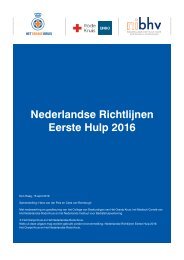Thesis-Anne-Vos-Masters-SBR-and-EU-Law-3
Thesis-Anne-Vos-Masters-SBR-and-EU-Law-3
Thesis-Anne-Vos-Masters-SBR-and-EU-Law-3
Create successful ePaper yourself
Turn your PDF publications into a flip-book with our unique Google optimized e-Paper software.
difficult to assess later on what possible impacts the shale gas projects had on the water. Finally,<br />
the Commission refers to the ambiguity surrounding the fact that hydraulic fracturing requires the<br />
injection of the wastewater (collected from the fracturing) back into the ground <strong>and</strong> whether this is<br />
allowed by the WFD. This uncertainty allows for different interpretations at the national level.<br />
3.5 REACH Regulation<br />
Regulation (EC) no. 1907/2006 concerns an integrated system for the Registration, Evaluation,<br />
Authorisation <strong>and</strong> Restriction of Chemicals (REACH). This Regulation generates information <strong>and</strong><br />
provisions on substances <strong>and</strong> their preparation <strong>and</strong> uses. Its purpose is to ensure a high level of<br />
protection of human health <strong>and</strong> the environment, including the promotion of alternative methods for<br />
assessment of hazards of substances, as well as the free circulation of substances on the internal<br />
market while at the same time enhancing competitiveness <strong>and</strong> innovation. The provisions shall<br />
apply to the manufacturers that place the substances on the market or use such substances on<br />
their own, in preparations or in articles <strong>and</strong> to the placing on the market of preparations. Firms that<br />
manufacture or import chemicals must evaluate the risks of these chemicals <strong>and</strong> take the<br />
necessary steps to manage those risks. REACH is based on the principle that it is for<br />
manufacturers, importers <strong>and</strong> downstream users to ensure that they manufacture, place on the<br />
market or use such substances that do not adversely affect human health or the environment. The<br />
leading principle is the precautionary principle. 112<br />
First of all, firms are obliged to register chemicals which they manufacture or import. This will be<br />
registered in a central database which is controlled <strong>and</strong> managed by the European Chemical<br />
Agency (ECHA). Without registration, production or placement on the European market of the<br />
substance is not possible. Some substances are exempted, e.g. if their risk is negligible. Once<br />
registered, the ECHA will be able to evaluate whether the firms comply with their obligations <strong>and</strong><br />
the requirements of REACH. Two kinds of evaluation may be carried out: dossier evaluation <strong>and</strong><br />
substance evaluation. This could lead to a restriction or authorisation procedure, to the<br />
harmonisation of the classification <strong>and</strong> labelling of the substance or to the supply of information to<br />
other authorities in order to adopt appropriate measures. 113 With regard to substances that are of<br />
extremely high concern, the authorisation procedure may apply (Title VII). These substances are<br />
listed in <strong>Anne</strong>x XIV to the Regulation. The aim is to ensure the good functioning of the internal<br />
market while assuring that the risks from substances of very high concern are properly controlled<br />
<strong>and</strong> that these substances are progressively replaced by suitable alternative substances or<br />
technologies where these are economically <strong>and</strong> technically viable. Finally, Title VIII allows for a<br />
restriction procedure. <strong>Anne</strong>x XVII contains restrictions for certain substances. This restriction may<br />
be that a substance shall not be manufactured, placed on the market or used unless it complies<br />
with the conditions of that restriction.<br />
With regard to access to information, Article 118 of REACH declares Regulation (EC) No.<br />
1049/2001 (regarding public access to European Parliament, Council <strong>and</strong> Commission documents)<br />
applicable to the documents held by the ECHA, unless paragraph 2 applies, which gives a list of<br />
information of which disclosure shall be deemed to undermine the protection of the commercial<br />
interests of the concerned person. Only where urgent action is essential to protect human health,<br />
safety or the environment, such as emergency situations, the ECHA may disclose this information.<br />
Article 119 sets out a list of information held by the ECHA on substances (on their own or in<br />
mixtures) that shall be made publicly available, free of charge, over the Internet.<br />
112<br />
Article 1, paragraph 1, REACH.<br />
113<br />
http://europa.eu/legislation_summaries/internal_market/single_market_for_goods/chemical_products/l21282_en.htm<br />
26



